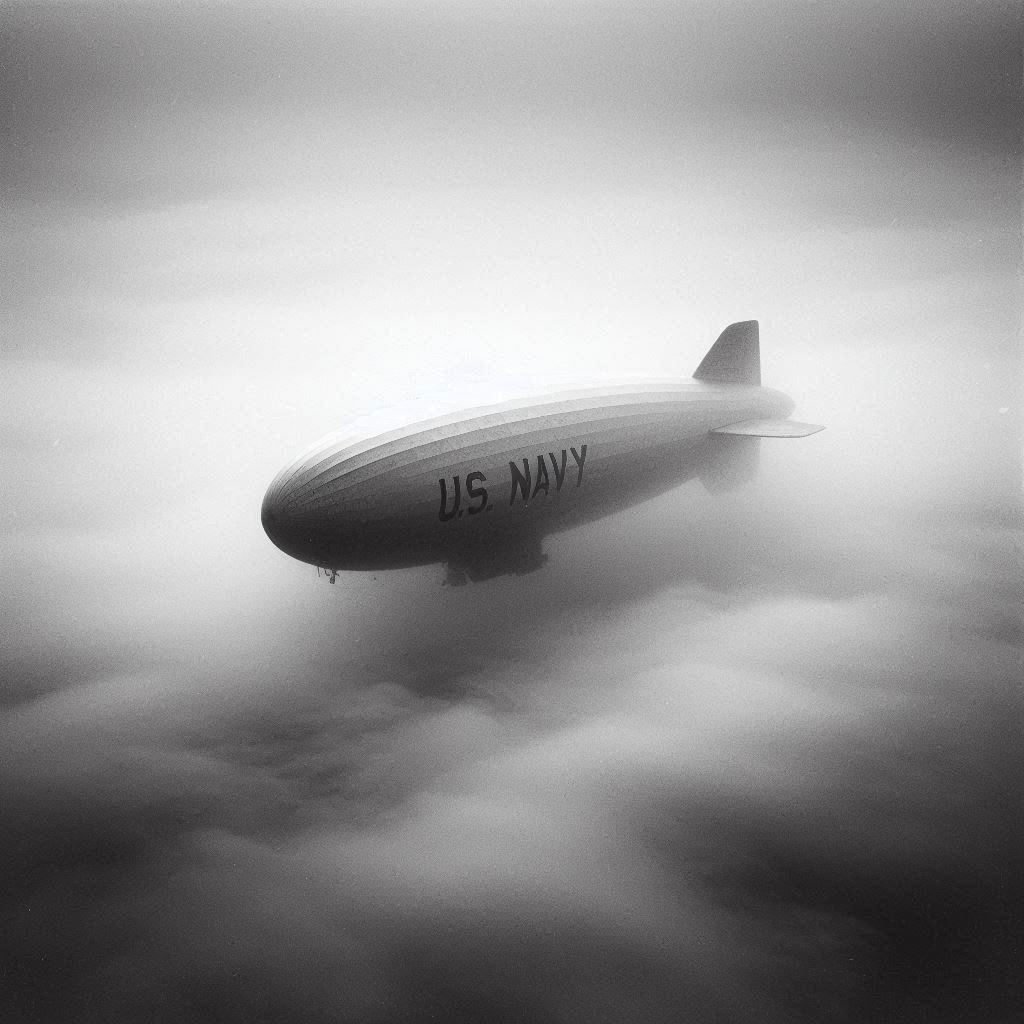Listen to “Two Airmen Vanish Without a Trace” on Spreaker.
It was the summer of 1942. The world was at war, and along the Pacific coast of the United States, tension hung in the air like the morning fog. People living near San Francisco knew the ocean wasn’t just beautiful — it was dangerous. Japanese submarines had been spotted off the coast before. Some had attacked ships. Everyone knew the enemy could be lurking beneath those rolling waves.
To defend against that threat, the U.S. Navy deployed an unusual weapon: blimps. They weren’t glamorous like fighter planes, and they weren’t massive like battleships, but they had one big advantage. They could stay in the air for hours, moving slowly, hovering, searching. From high above, they could spot submarines that might slip past faster planes. These airships became the silent guardians of the coastline.
One of them was a K-class blimp, tail number L-8. And on the morning of August 16, 1942, it lifted off for what was supposed to be a simple, routine patrol. Two men were onboard.
The Crew
The pilot was Lieutenant Ernest Cody. He was in his late twenties, confident, and highly respected. He had logged countless hours in the sky and knew how to handle the unusual quirks of flying an airship. His co-pilot was Ensign Charles Adams. Like Cody, Adams was experienced and dependable. Together, they made a strong team — the kind of men their fellow servicemen trusted with protecting the coast.
Their mission that day was straightforward: escort a convoy of merchant ships moving up the California shoreline. Submarines often hunted in those waters, so the L-8 would act as a watchful eye, scanning for anything suspicious.
Before takeoff, ground crews checked everything. The engines were humming smoothly. Fuel tanks were full. Emergency gear — life vests, raft, flare guns — all there. Weather? Foggy, yes, but typical for the Bay Area in August. Nothing dangerous. At 6:03 a.m., the blimp lifted off from Moffett Field in Mountain View. It was just another patrol.
At least, that’s what everyone thought.
The Strange Message
For the first hour, things were quiet. Cody and Adams checked in over the radio, routine status updates. Then, at 7:42 a.m., something unusual crackled through the static.
Ground control heard Cody’s voice. His tone was strained, urgent. He mentioned seeing an oil slick on the water, which could mean only one thing: possibly a submarine. But before he could say more, the message cut off mid-sentence. Silence.
Radio operators tried to call back. No response. They called again. Still nothing.
Now, a missed transmission wasn’t automatically an emergency. Radios malfunctioned all the time. But the way Cody’s voice had sounded — clipped, hurried — it was enough to raise alarms. And in wartime, when submarines could strike at any moment, every second mattered. Navy aircraft in the area were told to look for the L-8. Ships were alerted. But no one could find the blimp.
The Ghost Appears
Hours passed. Then, just after 11 a.m., people in Daly City, just south of San Francisco, looked up and froze.
A massive silver airship was drifting silently over their homes. It was the L-8. Witnesses described it moving strangely, like no one was steering it. Its engines were still running, but the blimp seemed aimless, wandering in the wind.
The sight was surreal — a military airship gliding low, almost brushing rooftops. At one point, it snagged on telephone wires, breaking them, then tore a gash across a hillside. But instead of crashing, it kept floating, as if some invisible hand was guiding it.
Finally, the blimp descended onto a sandy beach near Fort Funston. It touched down softly, almost gently, like a feather landing. The gondola — the cabin where the crew sat — thudded onto the ground. Propellers still idled. Engines still hummed.
To onlookers, it looked like a routine landing gone slightly wrong. Maybe the pilots needed help. But when rescuers rushed forward and pulled open the door, what they saw made their stomachs drop.
Empty Seats
Inside the gondola, everything was normal. Too normal.
The radio was set to the right frequency. Headsets were in place. The controls were untouched. The life raft, untouched. Life vests, still neatly stored. Parachutes, folded. Flare guns, still in their case. Even the blimp’s logbook was open on the panel, as if one of the men had been writing in it just moments before.
And there, on the seats, were the crewmen’s caps.
But Cody and Adams? They were gone.
No blood. No signs of a fight. No bullet holes. No smashed equipment. No damage to the blimp itself. Just… gone.
The hatch on the side of the gondola was unlatched, hanging open. That detail chilled investigators. It meant the door had been opened by hand — from the inside.
The men had vanished from their blimp mid-flight, leaving behind a perfectly operational airship.
The Search
News of the discovery spread quickly. The Navy immediately launched an investigation. Dozens of aircraft and ships combed the waters near the L-8’s last radioed position. Divers explored possible crash zones. But nothing — not a body, not a shred of clothing, not even a life vest — was ever found.
How could two trained men just vanish without leaving any trace?
Investigators pieced through every possibility.
Theories
The Submarine Theory. Some believed the men had spotted a Japanese submarine and tried to attack. Maybe they leaned out of the gondola to drop a smoke marker or depth charge and somehow fell overboard. But there was no evidence of enemy subs in the area, and the blimp showed no signs of being fired upon.
The Accident Theory. Others suggested one man might have fallen accidentally, and the other jumped in a desperate attempt to save him. The unlatched hatch supported this idea. But both men falling to their deaths without even grabbing life vests? Hard to imagine.
Suicide or Desertion. Could Cody and Adams have intentionally abandoned their post? Investigators looked into their backgrounds. Both were loyal, professional, and had spotless records. There was no reason to believe they would desert.
Something Stranger. And then there were the wilder theories. Alien abduction. Secret government experiments. A classified mission gone wrong. These ideas had no evidence, but the sheer weirdness of the case left room for speculation.
No theory tied everything together neatly.
The Legacy of Silence
The official conclusion was unsatisfying: Cody and Adams were declared “missing, presumed dead.” The Navy quietly repaired the L-8 and put it back into service. Incredibly, that same blimp later became part of the Goodyear fleet after the war, flying harmlessly over sporting events — a floating billboard with a haunted past.
But the families of Cody and Adams never got answers. No remains. No closure. Just the knowledge that their loved ones vanished on what should have been a routine patrol.
And here’s the detail that sticks with people the most: when the rescuers boarded the blimp on that foggy morning, the engines were still purring, the controls still set, the hats of the crew still resting on their seats — as if the men had stepped out for a moment and planned to come right back.
Only they never did.
Why It Still Haunts Us
Most mysteries fade over time, buried under new stories. But the Ghost Blimp hasn’t. It lingers because of how ordinary it all seemed. Two men. A simple mission. A calm morning. And then, without warning, silence.
The Pacific Ocean has swallowed countless secrets. But this one feels different. A perfectly good airship lands itself, carrying all the belongings of its missing crew. It’s the kind of story that forces us to ask uncomfortable questions about how much of our world we truly understand.
And maybe that’s why, more than eighty years later, people are still talking about it. The Ghost Blimp isn’t just a wartime mystery. It’s a reminder that sometimes the scariest stories don’t end with explosions or dramatic battles. Sometimes, the scariest stories end with silence.




